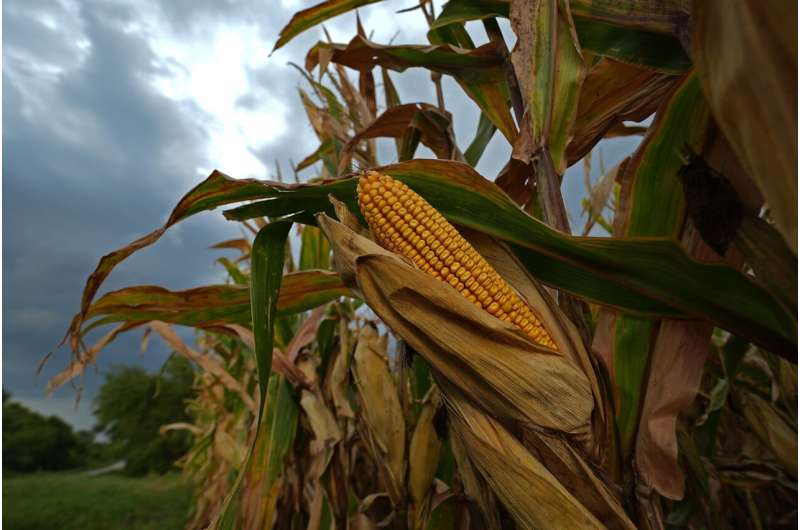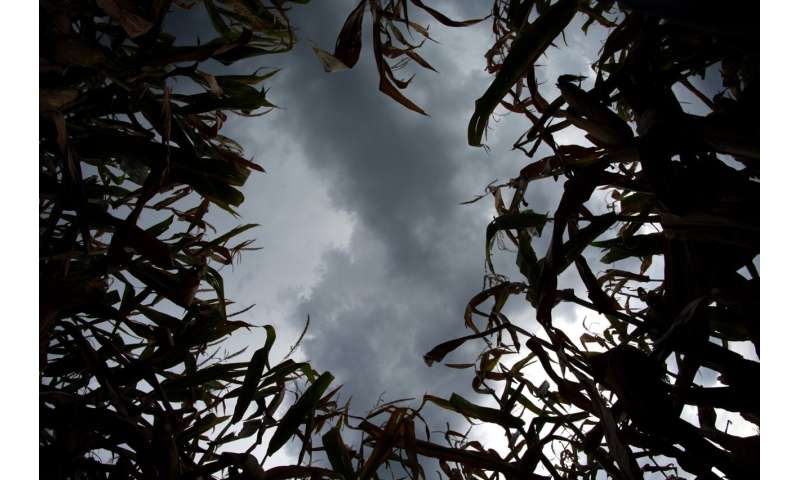This article has been reviewed according to Science X's editorial process and policies. Editors have highlighted the following attributes while ensuring the content's credibility:
fact-checked
reputable news agency
proofread
Sweaty corn is making it even more humid

Barb Boustead remembers learning about corn sweat when she moved to Nebraska about 20 years ago to work for the National Oceanic and Atmospheric Administration and found herself plunked down in an ocean of corn. The term for the late-summer spike in humidity from corn plants cooling themselves was "something that locals very much know about," Boustead, a meteorologist and climatologist, recalled.
But this hallmark of Midwestern summer might be growing stickier thanks to climate change and the steady march of industrial agriculture. Climate change is driving warmer temperatures and warmer nights and allowing the atmosphere to hold more moisture. It's also changed growing conditions, allowing farmers to plant corn further north and increasing the total amount of corn in the United States.
Farmers are also planting more acres of corn, in part to meet demand for ethanol, according to the USDA's Economic Research Service. It all means more plants working harder to stay cool—pumping out humidity that adds to steamy misery like that blanketing much of the U.S. this week.
It's especially noticeable in the Midwest because so much corn is grown there and it all reaches the stage of evapotranspiration at around the same time, so "you get that real surge there that's noticeable," Boustead said.
Dennis Todey directs the U.S. Department of Agriculture's Midwest Climate Hub, which works to help producers adapt to climate change. He said corn does most of its evapotranspiration—the process of drawing water up from the soil, using it for its needs and then releasing it into the air in the form of vapor—in July, rather than August.

He said soybeans tend to produce more vapor than corn in August.
Todey said more study is necessary to understand how climate change will shape corn sweat, saying rainfall, crop variety and growing methods can all play a part.
But for Lew Ziska, an associate professor of environmental health sciences at Columbia University who has studied the effects of climate change on crops, warmer conditions mean more transpiration. Asked whether more corn sweat is an effect of climate change, he said simply, "Yes."
He also noted increasing demand for corn to go into ethanol. Over 40% of corn grown in the U.S. is turned into biofuels that are eventually guzzled by cars and sometimes even planes. The global production of ethanol has been steadily increasing with the exception of a dip during the COVID-19 pandemic, according to data from the Renewable Fuels Association.
-

Storm clouds build as corn grows on Tuesday, Aug. 27, 2024, near Platte City, Mo. Credit: AP Photo/Charlie Riedel -

Storm clouds build above a corn field Tuesday, Aug. 27, 2024, near Platte City, Mo. Credit: AP Photo/Charlie Riedel -

Storm clouds build above a corn field Tuesday, Aug. 27, 2024, near Platte City, Mo. Credit: AP Photo/Charlie Riedel -

Storm clouds build above a corn field Tuesday, Aug. 27, 2024, near Platte City, Mo. Credit: AP Photo/Charlie Riedel
The consumption of ethanol also contributes to planet-warming emissions.
"It shouldn't come as a surprise to anyone that it's been getting hotter. And as a result of it getting hotter, plants are losing more water," Ziska said.
© 2024 The Associated Press. All rights reserved. This material may not be published, broadcast, rewritten or redistributed without permission.




















